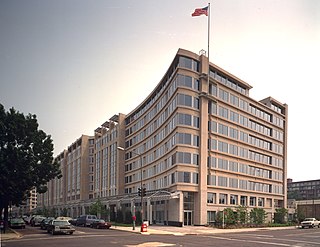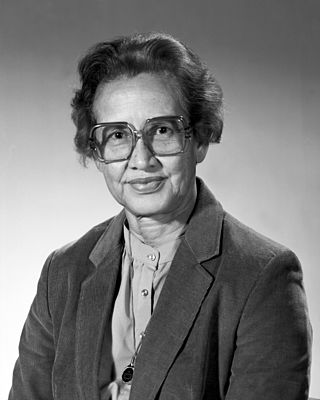Related Research Articles

Plainfield is a city in Union County, in the U.S. state of New Jersey. Nicknamed "The Queen City", it serves as both a regional hub for Central New Jersey and a bedroom suburb of the New York Metropolitan area, located in the Raritan Valley region. As of the 2020 United States census, the city's population, majority Latino for the first time, was 54,586. This was an increase of 4,778 (+9.6%) from the 2010 census count of 49,808, which in turn reflected an increase of 1,979 (+4.1%) from the 47,829 counted in the 2000 census. In 2022, the Census Bureau estimated the city's population to be 54,513.

Surveyor 2 was to be the second lunar lander in the uncrewed American Surveyor program to explore the Moon. After launch on September 20, 1966 a mid-course correction failure resulted in the spacecraft losing control. Contact was lost with the spacecraft at 9:35 UTC, September 22.

Walter Marty Schirra Jr. was an American naval aviator, test pilot, and NASA astronaut. In 1959, he became one of the original seven astronauts chosen for Project Mercury, which was the United States' first effort to put humans into space. On October 3, 1962, he flew the six-orbit, nine-hour, Mercury-Atlas 8 mission, in a spacecraft he nicknamed Sigma 7, becoming the fifth American and ninth human to travel into space. In December 1965, as part of the two-man Gemini program, he achieved the first space rendezvous, station-keeping his Gemini 6A spacecraft within 1 foot (30 cm) of the sister Gemini 7 spacecraft. In October 1968, he commanded Apollo 7, an 11-day low Earth orbit shakedown test of the three-man Apollo Command/Service Module and the first crewed launch for the Apollo program.

Janet Lynn Kavandi, a native of Carthage, Missouri, is an American scientist and a NASA astronaut. She is a veteran of three Space Shuttle missions, served as NASA's Deputy Chief of the Astronaut Office, and was the Center Director at the NASA Glenn Research Center in Cleveland, Ohio from March 2016 until her retirement from NASA in September 2019. She was inducted into the United States Astronaut Hall of Fame in 2019.
Evelyn Boyd Granville was the second African-American woman to receive a Ph.D. in mathematics from an American university; she earned it in 1949 from Yale University. She graduated from Smith College in 1945. She performed pioneering work in the field of computing.

NASA's Christopher C. Kraft Jr. Mission Control Center, also known by its radio callsign, Houston, is the facility at the Lyndon B. Johnson Space Center in Houston, Texas, that manages flight control for the United States human space program, currently involving astronauts aboard the International Space Station (ISS). The center is in Building 30 at the Johnson Space Center and is named after Christopher C. Kraft Jr., a NASA engineer and manager who was instrumental in establishing the agency's Mission Control operation, and was the first Flight Director.

The Mary W. Jackson NASA Headquarters is a low-rise office building in the two-building Independence Square complex at 300 E Street SW in Washington, D.C. The building houses NASA leadership who provide overall guidance and direction to the US government executive branch agency NASA, under the leadership of the NASA administrator. Ten field centers and a variety of installations around the country conduct the day-to-day work.

Creola Katherine Johnson was an American mathematician whose calculations of orbital mechanics as a NASA employee were critical to the success of the first and subsequent U.S. crewed spaceflights. During her 33-year career at NASA and its predecessor, she earned a reputation for mastering complex manual calculations and helped pioneer the use of computers to perform the tasks. The space agency noted her "historical role as one of the first African-American women to work as a NASA scientist".

Barbara Crawford Johnson was an American aeronautical engineer. She was the one woman in NASA's engineering team that participated in arrival on the Moon. She conducted significant and important studies on flight dynamics, missile design, wind tunnels, performance analysis, and aerodynamics. In 1968, she was appointed the highest position ever achieved by a woman in her department: manager of the Apollo Program.

Christine Darden is an American mathematician, data analyst, and aeronautical engineer who devoted much of her 40-year career in aerodynamics at NASA to researching supersonic flight and sonic booms. She had an M.S. in mathematics and had been teaching at Virginia State University before starting to work at the Langley Research Center in 1967. She earned a Ph.D. in engineering at George Washington University in 1983 and has published numerous articles in her field. She was the first African-American woman at NASA's Langley Research Center to be promoted to the Senior Executive Service, the top rank in the federal civil service.
The West Computers were the African American, female mathematicians who worked as human computers at the Langley Research Center of NACA from 1943 through 1958. These women were a subset of the hundreds of female mathematicians who began careers in aeronautical research during World War II. To offset the loss of manpower as men joined the war effort, many U.S. organizations began hiring, and actively recruiting, more women and minorities during the 1940s. In 1935, the Langley Research Center had five female human computers on staff. By 1946, the Langley Research Center had recruited about 400 female human computers.

Dorothy Jean Johnson Vaughan was an American mathematician and human computer who worked for the National Advisory Committee for Aeronautics (NACA), and NASA, at Langley Research Center in Hampton, Virginia. In 1949, she became acting supervisor of the West Area Computers, the first African-American woman to receive a promotion and supervise a group of staff at the center.

Hidden Figures is a 2016 American biographical drama film directed by Theodore Melfi and written by Melfi and Allison Schroeder. It is loosely based on the 2016 non-fiction book of the same name by Margot Lee Shetterly about three female African-American mathematicians: Katherine Goble Johnson, Dorothy Vaughan, and Mary Jackson, who worked at NASA during the Space Race. Other stars include Kevin Costner, Kirsten Dunst, Jim Parsons, Mahershala Ali, Aldis Hodge, and Glen Powell.

Margot Lee Shetterly is an American nonfiction writer who has also worked in investment banking and media startups. Her first book, Hidden Figures: The American Dream and the Untold Story of the Black Women Who Helped Win the Space Race (2016), is about African-American women mathematicians working at NASA who were instrumental to the success of the United States space program. She sold the movie rights while still working on the book, and it was adapted as a feature film of the same name, Hidden Figures (2016). For several years Shetterly and her husband lived and worked in Mexico, where they founded and published Inside Mexico, a magazine directed to English-speaking readers.

Mary Jackson was an American mathematician and aerospace engineer at the National Advisory Committee for Aeronautics (NACA), which in 1958 was succeeded by the National Aeronautics and Space Administration (NASA). She worked at Langley Research Center in Hampton, Virginia, for most of her career. She started as a computer at the segregated West Area Computing division in 1951. In 1958, after taking engineering classes, she became NASA's first black female engineer.

Hidden Figures: The American Dream and the Untold Story of the Black Women Who Helped Win the Space Race is a 2016 nonfiction book written by Margot Lee Shetterly. Shetterly started working on the book in 2010. The book takes place from the 1930s through the 1960s, depicting the particular barriers for Black women in science during this time, thereby providing a lesser-known history of NASA. The biographical text follows the lives of Katherine Johnson, Dorothy Vaughan, and Mary Jackson, three mathematicians who worked as computers at NACA and NASA, during the space race. They overcame discrimination there, as women and as African Americans. Also featured is Christine Darden, who was the first African-American woman to be promoted into the Senior Executive Service for her work in researching supersonic flight and sonic booms.

Powtawche N. Valerino is an American mechanical engineer at the NASA Jet Propulsion Laboratory. She worked as a navigation engineer for the Cassini mission.

Gladys Mae West is an American mathematician. She is known for her contributions to mathematical modeling of the shape of the Earth, and her work on the development of satellite geodesy models, that were later incorporated into the Global Positioning System (GPS). West was inducted into the United States Air Force Hall of Fame in 2018. West was awarded the Webby Lifetime Achievement Award for the development of satellite geodesy models.

Sharon Caples McDougle is an American retired spacesuit technician for National Aeronautics and Space Administration, crew chief, and manager of the Space Shuttle Crew Escape Equipment Processing department. She is the first Black woman to serve in these roles.

Kathryn Peddrew was an African-American mathematician, engineer, and scientist who played a crucial role in the National Advisory Committee for Aeronautics (NACA) and the National Aeronautics and Space Administration (NASA). She was one of the African-American women who worked as a "human computer" at NACA's Langley Research Center in the 1940s and 1950s.
References
- 1 2 3 4 "Marion Lee Johnson". Cincinnati Museum Center. Retrieved 2020-07-12.
- 1 2 3 4 5 6 7 8 Golden Carmon, Rev. W. (May 15, 2017). "Marion Lee Johnson: A Hidden Figure". The Christian Recorder. Retrieved October 8, 2019.
- 1 2 Journal, Caitlin Mota | The Jersey (2017-02-26). "Jersey City teacher honored as one of N.J.'s own 'Hidden Figures'". nj. Retrieved 2020-07-12.
- 1 2 Monks, Michael (18 February 2020). "'Hidden Figure' Marion Lee Johnson Talks NASA Career". www.wvxu.org. Retrieved 2020-07-12.
- 1 2 "NJ's own 'Hidden Figure' delivers powerful speech on the importance of mentoring | Video". NJTV News. Retrieved 2020-07-12.
- 1 2 Segedy, Andria. "Savannah's own 'Hidden Figure': Marion Lee Johnson worked on Apollo 11 program". Bluffton Today. Retrieved 2019-10-08.
- ↑ "Black History Month One-On-One: 'Hidden Figure' Marion Lee Johnson". 2018-02-01. Retrieved 2019-10-08.
- 1 2 3 "Black History Month One-On-One: 'Hidden Figure' Marion Lee Johnson". 2018-02-01. Retrieved 2020-07-12.
- 1 2 "Here and Now on March 26, 2017: Marion Johnson". ABC7 New York. 2017-03-29. Retrieved 2020-07-12.
- ↑ "Mathematician and Engineer Marion Johnson, of the Apollo 11 Mission, Inspires Girl Scouts to Become America's Next Tech Leaders". TAPinto. Retrieved 2020-07-12.
- ↑ "Marion Lee Johnson Day - City of Plainfield". Central Jersey Alumnae Chapter of Delta Sigma Theta Sorority, Incorporated. Retrieved 2020-07-12.